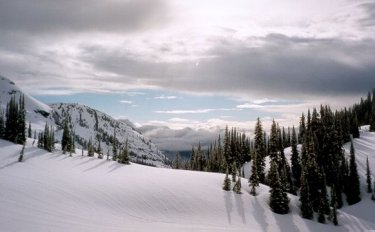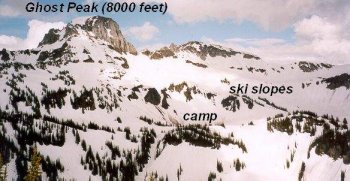My brother John and I experienced
a bit of spring followed by a whole lot of winter during a backcountry ski
trip to the Selkirk Mountains of British Columbia, June 7-12, 2000. The corn
snow yielded superb turning and the powder was even better, despite the determined
efforts of the strong June sun to turn the fresh cover into slop. We felt
as though we had cheated Mother Nature by enjoying quality powder turns a
mere ten days before the summer solstice, especially satisfying because she
had unleashed some awful weather upon us in the process.
n
Day 1
At 4 p.m. we flew in a helicopter from Revelstoke (elevation 1450 feet) to
a lake (6500 feet) at the foot of Ghost Peak (8000 feet). When the helicopter
skids set down I was glad for two things: (1) the snow was firm, as noted by
the pilot, and (2) the surface of the snow was dirty (dust- and lichen-covered).
I was pleased, as these observations meant that the snowpack was well-consolidated
and that it hadn’t snowed recently. Fresh snow during a late spring trip is
generally a bad thing because it often quickly converts to slop in the strong
sun, thereby making traveling and turning difficult, and the avalanche hazard
increases significantly.
|
|
We spent a week up here in mid-May last year, when the snowpack had achieved
record maximum depths. It snowed every day during that trip, and as a consequence
we made precious few quality turns. That snowpack was 10 to 15 feet deep, whereas
this year it was 6 to 8 feet, still well above average. The steep south-facing
slopes that avalanched throughout the winter were pocked with small exposed
patches of dirt and rock. More importantly, there was a small area of open water
at the outlet to the lake, meaning that we didn’t have to melt snow for drinking
and cooking water. That would translate into many fewer hours spent crouched
over the stove.
The skies were overcast and we expected rain to start at any moment while setting
up camp, but it did not, instead gathering strength to drench us later in the
trip. Since the forecast was calling for unsettled weather during the week,
we decided to make some late afternoon / evening turns. We found that the snow
was so sticky and consolidated near timberline that skins were not needed on
gentle and moderate slopes. Up in the alpine, though, the snow was slicker and
top surface was much softer. We made a couple runs of 600-800 feet vertical.
Due to the softness of the corn snow (our skis penetrated down 6-12 inches in
the middle of the turns), we couldn’t arc high-speed turns, but still found
the turning to be highly enjoyable. [Selkirk_02.jpg] During dinner, John remarked
that we had already made more quality turns than our entire trip last year.
I concurred.
Day 2
Clouds overnight kept the snowpack from freezing, yielding conditions similar
to those of the previous afternoon. We skinned through a low pass to the south
of camp. Upon going through the pass we saw wolf tracks that were heading in
the opposite direction, toward our camp. The tracks were fresh, a couple hours
old at most, but we scanned the bowl and saw nothing. We were wondering what
the wolf was hoping to find up here, as we noted no animal life other than a
couple small birds and a solitary pika.
We made three runs of 1200 vertical feet each before the huge mass of clouds
to the south moved overhead at noon and started pouring out rain. Luckily, we
were near a high point when it began raining, so we had a quick downhill trip
to the tents before getting wet. It rained the rest of the day.
Day 3
The rain fell all night, and didn’t relent until 2 p.m. The sun poked through
as we quickly skied to the slopes to the west of camp, on the eastern flank
of Mount Cartier (8560 feet). We made one long run down Cartier in excellent,
water-logged corn snow. The turning was best on the steepest pitches, whereas
it was slow turning in the sticky, albeit firmer snow near timberline. I hypothesized
that the spruce pitch from the trees caused the stickiness. Upon heading back
to camp we scoped out what are undoubtedly the best ski slopes in the area.
1500 feet vertical with lots of steep, but not too steep, gradients. The skin
track back up could be done on gentler slopes. Those slopes were to be our destination
for the next day, assuming that the weather held.
At the beginning of dinner bright sun poked though big clouds. During dessert,
however, a huge black thundercloud parked overhead and began to pound down various
types of frozen precipitation: graupel, ice pellets, wet snow, etc. A few bolts
of lightning struck the ground nearby.
Day 4
The precipitation turned to wet snow overnight and continued with moderate
intensity throughout the day, accumulating to a fresh depth of six inches or
so. Given the flatness of the light and the wetness of the new snow, we decided
to stay in the tent, keeping dry and reading books. I was bitter with arrival
of the new snow, remarking to John that “the skiing part of our trip was done”
because the new snow would turn into slop once it got bright enough for us to
ski, and that the avalanche danger would skyrocket because the bond between
the new snow and the probably frozen hard corn beneath would be poor. I experienced
such conditions in Les Monts Chic-Choc a few years
ago and found them to be scary. Nevertheless, we planned on getting an early
start the next morning with hopes that the snow had stopped and that maybe we
could make some turns on shallow slopes. At the least, I figured, the new snow
would make for pretty photos.
Day 5
|
|
I slept in until later than planned, arising at 5:30 a.m., because I figured
that conditions were poor. We skipped breakfast and were skinning a half-hour
later. When my skis first hit the snow I was encouraged that the snowfall had
become considerably drier overnight, resulting in about 4 inches of fluff, and
that the corn snow underneath the new snow had not frozen rock-hard. I had no
idea how the corn had remained unfrozen, as the temperature had dropped to well
below freezing. Perhaps the new snow had insulated it.
Whatever the case, there was a perfect set-up for spring powder skiing: soft
corn overlain by a layer of ice pellets and wet snow, followed by progressively
drier snow and topped by a couple of inches of fluff. I jumped on the snowpack
on a couple of steep, short pitches and found the bond between the old and new
snow to be strong, allowing us to continue onto the steeper slopes to the east
of camp. The key, however, was moving quickly because the new fluff would not
stand up favourably to the rising sun; whether or not it actually shined through
the clouds, its radiation energy would cook the snow. We choose to ski a southwest-facing
slope, which was a good call because the sun rises in the northeast at this
time of year, and a nearby ridge to the east blocked the sun entirely until
about 8 a.m.
We started with short runs and progressively made them longer by skinning
higher up the slope. The longest run provided about 1000 feet of vertical drop.
The turning was outrageous: the powder on top made the snow fast and soft, while
the unfrozen corn beneath provided a consistent base. I got a couple of legitimate
“face-shots”, but then again I’m a telemarker who likes to bend my knees deeply.
At first the light was flat due to the thick cloud deck, but then the sun began
poking through the rapidly moving clouds for a few seconds at intervals of every
couple of minutes. We could see the holes in the clouds developing on the slopes
across the bowl, and we could predict when they’d pass overhead, thereby allowing
us to time our descents for when they were upon us. This timing on a couple
of runs was impeccable, with snow squalls settling in during the skin up, cooling
us and “protecting” the powder, and then broken clouds with some sun illuminating
the surface during the descent. Sunshine on the slopes illustrated all of the
terrain contours, allowing more aggressive, faster, and therefore more enjoyable
turning.
During one squall, I knew that we were experiencing special conditions when
a bumble bee began buzzing us, thinking that we were huge flowers. I’ve rarely,
if ever, swatted at a bee with a ski pole, and certainly never while it was
snowing.
The cloud deck was lifting and dissipating, prompting us to skin and ski even
more quickly before the powder inevitably became overheated. This real urgency
added to the excitement of skiing powder in June. Just when we thought the sun
was about to completely bathe the slope, a snow squall appeared out of nowhere
and laid down a quick half inch in ten minutes. With the passing of the squall,
the sun finally did completely wash across the slope. It was noon, we had been
working hard for six hours without breakfast, and our water bottles were empty.
Given that we were exhausted and that the sun was beginning to have detrimental
effects on the powder, we made one final run down to the camp.
The sun broke out in earnest after we arrived at camp. The temperature soared
in the direct sunlight, making it comfortable to stand outside of the tent in
shorts and T-shirts. As the heat started feeling good, a cloud would pass overhead,
dropping the temperature many tens of degrees Fahrenheit instantly, and snow
would start flying. I don’t think I’ve ever felt such drastic temperature swings.
When we thought the clouds were going to disappear for good, another huge black
cloud from the south arrived and brought another bout of heavy snow.
A strong east wind kicked up and started blowing the new snow around. Large
plumes blew off nearby ridges, showing us how the 20-foot thick cornices that
were overhanging parts of the bowl formed. Our ski tracks quickly disappeared
in the blizzard-like conditions. We were tent bound again.
Day 6
The wind died during the night but the snow kept dumping steadily. Our scheduled
4 p.m. pickup by the helicopter was in jeopardy. Miraculously, at 4 p.m. the
snow stopped just as we could hear the helicopter slowly working its way up
through the clouds from Revelstoke. We packed up camp, jumped in the copter,
and took off before another wave of nasty weather rolled in.
Despite being tent bound for three complete days and parts of three other days,
it was still one heck of a ski trip. The fact that we got a taste of good corn
snow skiing, but were denied from the best slopes, whetted our appetite for
more Selkirk turning. Skiing in true dry powder ten days before the summer solstice
was something special. Simply experiencing the beauty and power of nature in
the alpine made the trip worthwhile, especially for two guys who now live at
sea-level. We’ll be back next year.







